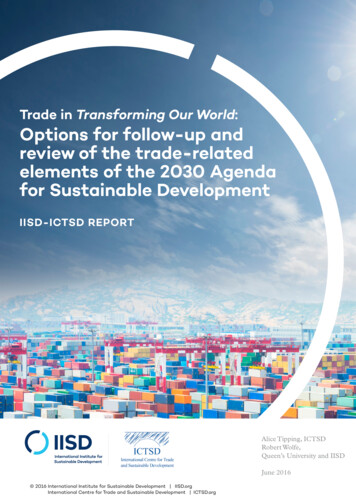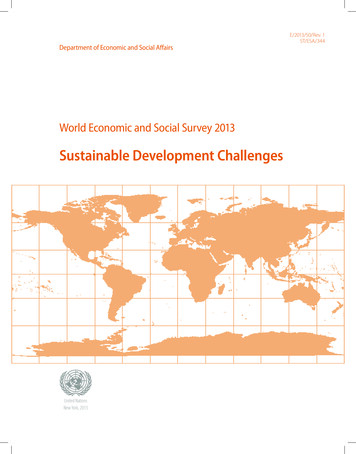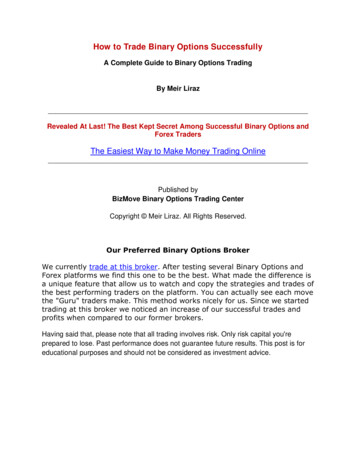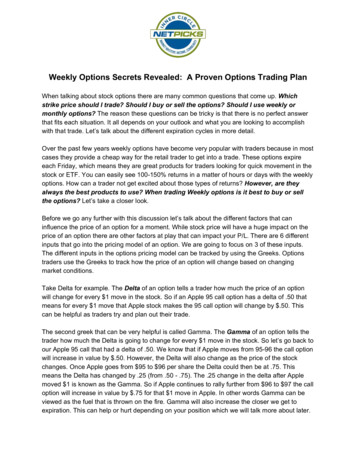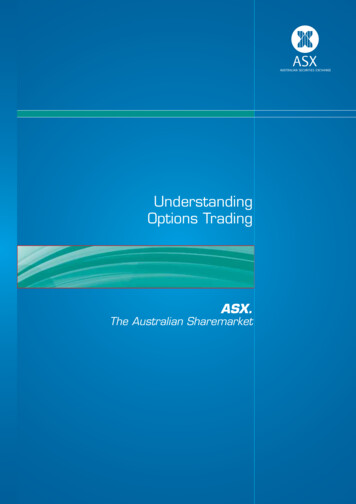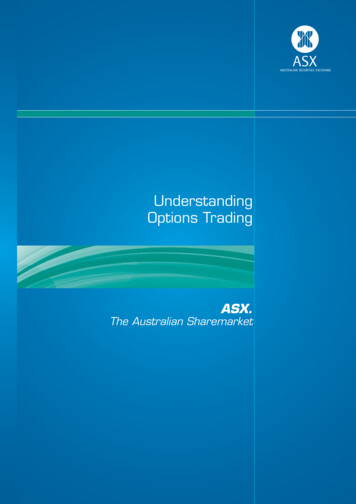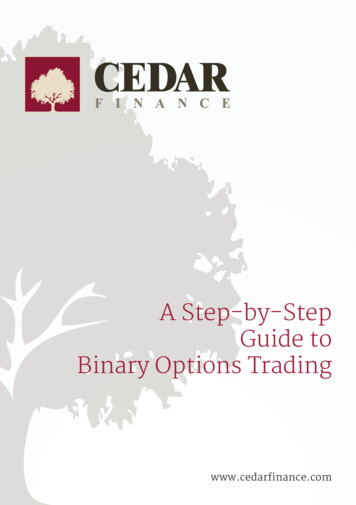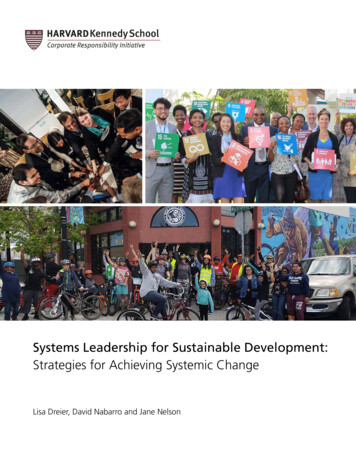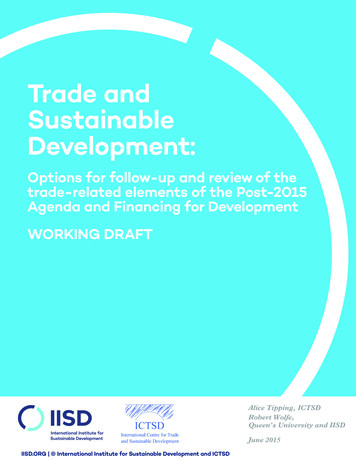
Transcription
Trade andSustainableDevelopment:Options for follow-up and review of thetrade-related elements of the Post-2015Agenda and Financing for DevelopmentWORKING DRAFTAlice Tipping, ICTSDRobert Wolfe,Queen’s University and IISDJune 2015IISD.ORG International Institute for Sustainable Development and ICTSD
Trade and sustainable development:Options for follow-up and review of the trade-related elements ofthe Post-2015 Agenda and Financing for DevelopmentAlice Tipping, ICTSDRobert Wolfe, Queen’s University and IISDWorking DraftJune 201511We anticipate revising this paper after the UN Summit in September 2015. We are grateful for thehelpful comments of many colleagues and officials.
Executive SummaryTrade and sustainable development: Options for follow-up and reviewTrade is reflected throughout the draft Sustainable Development Goals (SDGs) of June 2015 andthe May 2015 draft outcome of the third international Financing for Development (FfD)conference. These two high level meetings and their outcome documents will guide globaldevelopment work for the next 15 years. The first aim of this paper is to map where trade-relatedelements are found in the SDGs and FfD. The second aim is to describe the trade-relatedarchitecture for review and follow-up that could support these outcomes, and to map where itexists or could be built. The SDGs in themselves will not cause anything to change, let aloneensure policy coherence, but the review process might.Trade’s contribution to the post-2015 Agenda is diffuse, which means follow-up and review willbe a challenge, but it need not be overly burdensome, and it will be useful. This paper presentsan initial set of options for how progress towards these trade-related commitments could bereviewed in the years to 2030. The process would provide information on progress by UnitedNations (UN) Member States, based on inputs from governments, civil society and internationalorganizations. This information would be reviewed through self-assessment by Member Statesthemselves, and through peer review by other governments at the regional level (for example inUN regional commissions), and at the global level in multilateral agencies and the High LevelPolitical Forum (HLPF), the apex of the follow-up and review process. The point of these reviewprocesses is not “evaluation”, but the sharing of experiences as a way to facilitate learning andpolicy improvement.The paper identifies six clusters of trade-related elements in the draft SDGs and in the draft FfDoutcome. These elements, summarized in Box 1 below, range from improving access to marketsfor small-scale producers to strengthening the multilateral trading system. They includecommitments to reform of perverse subsidies to agriculture, fisheries and fossil fuels, and toensuring that regional trade and investment agreements are coherent with sustainabledevelopment objectives. For each cluster, the paper identifies current thinking on indicators,where the necessary data are already collected (if they are) and where progress against thesepolitical commitments could be reviewed. The paper then presents the information from anotherperspective, focusing on the potential roles of the various peer review mechanisms, summarizedin Box 2 below. These mechanisms range from multilateral reviews like the World TradeOrganization (WTO)’s Trade Policy Review Mechanism and UNCTAD’s voluntary policy peerreviews to regional mechanisms that could review groups of UN Members, like the Organisationfor Economic Co-operation and Development (OECD) or regional economic integrationorganizations like Asia-Pacific Economic Cooperation (APEC). The last part of the paperexplains how the various reports could be brought together. Given the profusion of options forreview mechanisms, an inter-agency task force on trade could provide an analytical synthesis ofreporting and reviews useful for discussions at national, regional and global levels of theinterrelated effects and trade-offs between goals. The broad mandate for such a task force, andperhaps others that would serve the Post-2015 review process, could be part of the Summitoutcome document, with details to be proposed by the agencies to the High-level Political Forumon sustainable development (HLPF)at its July 2016 meeting.
BMFNMoIMTSNGOOECDS&DTAsian Development BankWTO Agriculture Information Management SystemAgricultural Market Information SystemAsia-Pacific Economic CooperationAfrican Peer Review MechanismAgreement on Subsidies and Countervailing MeasuresAssociation of Southeast Asian NationsConvention on International Trade in Endangered SpeciesConference of PartiesCountry Policy and Institutional AssessmentWTO Committee on Regional Trade AgreementsWTO Committee on Trade and DevelopmentWTO Committee on Trade and the EnvironmentOECD Development Assistance CommitteeWTO Doha Development AgendaEconomic Commission for Latin America and the CaribbeanUN Economic and Social CouncilEnhanced Integrated FrameworkUN Food and Agriculture OrganisationFinancing for DevelopmentGroup of 20Global Sustainable Development Reportglobal value chainsHigh-level Political Forum on sustainable developmentInternational Energy Agencyinternational financial institutionsInternational Institute for Sustainable DevelopmentInternational Monetary FundInternational Trade CentreWTO Integrated Trade Intelligence PortalInternational Union for Conservation of Natureleast developed countrieslandlocked developing countriesUNCTAD's Market-access Tariff Trade Restrictiveness Indexmultilateral development bankmost favoured nationmeans of implementationmultilateral trading systemnon-governmental organisationOrganisation for Economic Co-operation and DevelopmentSpecial and Differential Treatment
SSouthern African Development CommunitySustainable Development GoalsUN System of Environmental-Economic Accountingsmall and medium-sized enterpriseWTO Committee on Sanitary and Phyto-santitary MeasuresWTO Agreement on Trade FacilitationOECD-WTO Trade in Value AddedWTO Trade Policy ReviewWTO Trade Policy Review BodyWTO Trade Policy Review MechanismTrade Records Analysis of Flora and Fauna in CommerceWTO Agreement on Trade-Related Aspects of IntellectualProperty RightsTTRIUNCTAD's Tariff Trade Restrictiveness IndexUNUnited NationsUNCDFUnited Nations Capital Development FundUNCTAD United Nations Conference on Trade and DevelopmentUNECEUnited Nations Economic Commission for EuropeUNEPUnited Nations Environment ProgrammeUNFCCC UN Framework Convention on Climate ChangeUNSCUnited Nations Statistical CommissionWHOWorld Health OrganisationWIPOWorld Intellectual Property OrganizationWTOWorld Trade Organization
Trade is related to each of the three dimensions of sustainable development—economic, socialand environmental. The Post-2015 Agenda is likely to include several trade policy-relatedelements across both the Sustainable Development Goals (SDGs) to be agreed at the UN Summitin September 2015, and the outcome document of the third Financing for Development (FfD)conference in July 2015.2 Trade-related targets are included in several SDGs. Some are goalspecific, but others see trade as a cross-cutting “means of implementation” (MoI) relevant to theachievement of every goal. In order to realize this potential, trade and other policies mustreinforce each other and not work at cross-purposes. Trade has to be part of a coherent policyframework for sustainable development. Follow-up and review of the trade-related elements ofthe agenda is essential: the SDGs in themselves will not cause anything to change, let aloneensure policy coherence, but the review process might.The proposed SDGs focus on expanding exports not obtaining high quality imports. Althoughthey recognize, if only implicitly, the importance of maintaining an open trade regime that wouldallow domestic firms access to low-cost inputs, they do not explicitly address the central role thatservices play in accessing global value chains (GVCs). And the SDGs are limited in devotinginsufficient explicit attention to things like trade costs that are important for participation inGVCs (Hoekman, 2015). But a universal, rules-based, open, non-discriminatory and equitablemultilateral trading system, as well as meaningful trade liberalization, in the words of the draftFfD outcome document, can serve as an engine of economic growth, not least by encouraginglong-term private and public investment in productive capacities, reduce poverty, and promotesustainable development. With appropriate supporting policies, infrastructure and an educatedwork force, according to the FfD draft, trade can promote employment, decent work andwomen’s empowerment, reduce inequality, and contribute to the realization of the SDGs.These aspirations may be feasible, in theory, but ensuring that trade makes this contribution tosustainable development will take concerted effort by many ministries within nationalgovernments, international organizations, civil society and the private sector. Unlike otheraspects of the SDGs and FfD, international trade is covered by numerous bilateral, regional andmultilateral agreements, which have their own review mechanisms. Trade’s contribution to thepost-2015 Agenda is diffuse, which means follow-up and review will be a challenge. Our firstaim with this paper is to map where trade-related elements are found in the SDGs and FfD. Box1 is a brief overview of where trade fits, based on the detailed mapping in the Annex.2In advance of the July and September outcomes we are assuming that the SDGs and FfD will bothcontribute to the Post-2015 Agenda, without prejudging the nature of the linkages between them.
2Box 1 Summary of possible indicators and review mechanisms3Trade-related Elements Potential indicators and sourcesPotential mechanisms for reviewCluster 1: Subsidies and commodities tradeAgricultural marketdistortionsFisheries SubsidiesWTO notifications, OECD data WTO Agriculture Cttee and TPRMand reviewsOECD Cttee for AgricultureWTO notifications,WTO SCM Cttee and TPRMOECD data, civil societyOECD Fisheries Cttee, FAOestimatesFossil Fuel SubsidiesIEA, OECD dataOECD/IEA Country Reviews, G20, UNFCCC, TPRMCommodity marketsUNCTAD commodity prices,UNCTAD Trade and Development Commission,AMFAO Commodity Markets Review Global Commodities ForumCluster 2 : Access to water, energy, medicinesTRIPS flexibilitiesUse of TRIPS flexibilities,WTO TRIPS Councilacceptance of amendment , WIPO Cttee on DevelopmentWHO monitoringCooperation on waterLevels of trade, tariffs on water WTO Cttee on Trade and Environment, TPRMtechnologymanagement-related goodsAPEC Cttee on Trade and InvestmentOECD Environmental Policy ReviewCooperation on cleanLevels of trade, tariffs on clean OECD Environment, Energy Reviewsenergy technologyenergyIEA Country ReviewsUNCTAD Investment ReviewsCluster 3: Economic diversification, global value chains, trade facilitationEconomicdiversificationDeveloping country and LDCUNCTAD Competition Policy Peer Reviewsexport diversification byWTO TPRMdestination, productAccess to financialDraw on work by World Bank, WTO Committee on Trade in Financial Servicesservicesand IMFIncrease Aid for TradeAid for Trade by recipient,Global Aid for Trade Reviewdonor (WTO, OECD data)Quality infrastructure, WTO Trade FacilitationWTO Trade Facilitation Ctteeparticipation in GVCsAgreementOECD Trade Cttee and DACWorld Bank logistics indicatorsWTO-OECD TiVA databaseInfrastructure, industry Trade, tariffs on environmentally WTO Trade and Environment Cttee, TPRMwith environmentalsound technologiesAPEC Cttee on Trade and InvestmenttechnologiesImplement S&DT inWTO Annual ReportWTO S&DT Monitoring MechanismWTOUNCTAD LDC ReportUNCTAD Trade and Development BoardTransparent,Transparency, sustainability of WTO TPRMsustainable government procurementprocurementCluster 4: Illegal extraction and trade in natural resources, trade in hazardous chemicals and wasteEnvironmentally soundUNEP Global Chemicals Outlook Basel Convention implementation andmanagement of wastesCompliance Cttee, UNEP3This tables is a summary of the more extensive material found in the Annex.
3Access and benefitABS measures (Convention on Convention on Biological Diversitysharing of geneticBiological Diversity)resourcesPoaching, trafficking of IUCN Red List, CITES Review of CITES, WTO Cttee on Trade and EnvironmentwildlifeSignificant TradeCluster 5: Multilateral trading system, regional trade and investment agreementsDeveloping countryWTO AccessionsWTO General Council, RTA Cttee,participation in globalParticipation in RTAsUNCTAD Trade and Development BoardgovernanceInvestment promotion UNCTAD Investment PolicyUNCTAD Investment Policy Reviewsin developing countries MonitorDissemination ofTrade in environmental goodsWTO Cttee on Trade and Environment, TPRMenvironmentaland servicesOECD Environmental Policy and Energy ReviewstechnologyInternational capacity- Aid for Trade expenditure,WTO Cttee on Trade and Development, WTObuildingEnhanced Integrated Framework Standards and Trade Development Facilityfor LDCsOECD DACStrengthen multilateral Trade Restrictiveness Indicator WTO General Council,trading system,(WTO-UNCTAD-World Bank-ITC) WTO Trade Monitoring Reportcomplete DDA, combat Average tariffs, prevalence ofUNCTAD Trade and Development Commissionprotectionismnon-tariff barriers by sector, levelof developmentBali Package implementationIncrease developingDeveloping country, LDC exports WTO Cttee on Trade and Development, Subcountry exportsAverage tariffs faced by LDCsCttee on LDCs(DFQF, ROO)Preference utilisation by LDCsCluster 6: Policy coherence for sustainable developmentDomestic enablingWorld Bank CPIA, Global Report WTO TPRMenvironment for tradeUNCTAD Investment, Competition Policy PeerReviews, African Peer Review MechanismStrengthen regionalADB regional integrationUN Regional Commissions Forums on Sustainableintegration and tradeindicatorsDevelopmentagreementsOECD, UNCTAD data on ‘depth’ WTO Cttee on Regional Trade Agreementsof regional agreementsInvestment agreements UNCTAD World InvestmentUNCTAD Investment Policy Reviews, Worldwith safeguards forReviewInvestment ForumsustainableOECD Trade CommitteedevelopmentPolicy space forConstraints in aid or loanOECD Development Assistance CommitteesustainableagreementsUNCTAD Trade and Development CommissiondevelopmentReview and Follow-up for the SDGs and FfDMechanisms for reviewing progress will be essential to the interconnected challenges ofachieving the SDGs and the FfD commitments. Having articulated the goals, states have todecide on whose agenda they should be placed. Follow up mechanisms will enable the world tounderstand how things are working so that program adjustments can be made. Review will alsoallow states to learn from the experience of others; and shed light on whether states are
4individually and collectively on track to meet their objectives. Most of the needed action onsustainable development is national, even local. In this sense the new paradigm is bottom-up nottop-down. The purpose of review mechanisms is thus to allow consideration of whether nationallaw, policy, and implementation are consistent with each state’s aspirations for achieving theSDGs. It is also a universal agenda: the goals will address all countries, at whatever level ofdevelopment. Regional and global as well as national review will be needed, therefore, becausewhat happens in one part of the world has effects in others, and because of the interrelated effectsand trade-offs among the goals. Global review is also needed because countries in differentregions or at the same level of development may face similar challenges and hence have lessonsto share.The June zero draft of the outcome document for the September Summit devotes one chapter toreview and follow up, with the new High-Level Political Forum (HLPF) on sustainabledevelopment at the apex. That chapter is aspirational, suggesting that review should identifyachievements and critical success factors, support countries in making informed policy choicesand mobilize the necessary means of implementation and partnerships. Mechanisms should buildon existing platforms and processes, and be rigorous and evidence-based. We have looked forplaces where SDGs-related data could be enhanced using existing reporting mechanisms, andwhere existing review mechanisms could continue to function as before, but with a strongerorientation to the SDGs. The essential objective is to ensure that the new system does not placean excessive burden on states. The opportunity to shape the system is now: the Summit outcomedocument in September may not solve the whole puzzle, but it can give guidance that will berelevant for negotiations in the ensuing months. Our second aim in this paper, therefore, is todescribe the architecture for review and follow-up, and to map where its elements exist or couldbe built. An overview of this part of the mapping, also based on the Annex, is found in Box 2below.Outline of the argumentIn the first section of this paper, we discuss principles for thinking about review mechanisms,followed by a brief discussion in the second section of architectural options for review. The thirdsection reports on a mapping exercise designed to show where trade figures in the SDGs and inthe FfD outcome, current thinking on indicators, and where the necessary data are alreadycollected. The fourth section describes where trade-related review and follow-up mechanismsalready exist, assessing where trade-related reporting can be discussed as a way to learn from theexperiences of others, and benefit from the suggestions of peers. While they overlap, the focus ofsection three is on the clusters of goals; the focus of section four is on the organizations. Theydraw on the same detailed mapping in the Annex, but use it in distinct ways. The profusion ofoptions for review mechanisms suggests that some kind of analytical synthesis of reporting at aglobal level would be helpful. Without such an analytical synthesis, trade’s vital contribution tosustainable development may be obscured. The conclusion therefore suggests that an interagency task force could be responsible for aggregation of all the trade-related reports for thepurposes of discussion of the interrelated effects and trade-offs between goals.
51. Principles for thinking about the review mechanismWhat is the purpose of review and follow-up? What principles and design considerations need tobe taken into account in establishing mechanisms? This paper relies on an analytic frameworkdeveloped by the International Institute for Sustainable Development (IISD) (Halle and Wolfe,2015; see also Halle, Najam and Wolfe, 2014; IISD, 2014). It is based on questions to be askedin any analysis of a review mechanism (Mashaw, 2005). Asking these questions helps us to besure that we have systematically considered all the salient factors. The questions are:1.2.3.4.5.6.7.Who is being reviewed;By whom;About what are they being reviewed;Through what processes the review is to be conducted;By what standards the relevant policies and practices are to be assessed;What the potential effects of the review are, or why review; and,Is the review feasible, and practical?We take these questions in order.1. Who is to be reviewed?The zero draft, and the resolution creating the HLPF (A/RES/67/290), consistent with theuniversal nature of the proposed SDGs, specifies that developed countries, developing countries,and relevant United Nations (UN) entities would be reviewed. In principle all bodies with atrade-related mandate could be reviewed, from the World Trade Organization (WTO) tomultilateral environmental agreements, like the Convention on International Trade inEndangered Species (CITES).42. By whom?In this paper we look only at self-assessment by governments and international organizations,peer review by governments of the actions of other governments, and the role of internationalorganizations in support of reviews. The zero draft says that the HLPF will be the apex of aglobal network of review processes. It is an intergovernmental body, but civil society has accessto all documents, has the right to submit documents, and can speak in plenary. Review at otherlevels is meant to be similarly open and participatory, although it can only happen in accordancewith a country or an international organization’s usual practices.5This list might seem expansive, but see zero draft section III para 9 “We reaffirm that the HLPF shallcarry out regular reviews of progress in line with Resolution 67/290. Reviews will be voluntary, whileencouraging reporting, and include developed and developing countries as well as relevant UN entities.”67/290 para 17 refers to “the organizations of the United Nations system, including the Bretton Woodsinstitutions and other relevant intergovernmental organizations, including the World TradeOrganization ”45People familiar with civil society involvement in organizations like the WTO (Halle, Wolfe and Beaton,2011) may be surprised that consistent with UN Economic and Social Council (ECOSOC) resolution
63. About what?For purposes of this paper we have limited ourselves to mapping the trade-related goalsarticulated in the SDGs and FfD, as discussed in the next section. At time of writing, it is notclear whether Member states will decide to include the FfD outcome, along with the SDGs, inthe follow-up and review of the broader Post-2015 Agenda. For the purposes of analysis, weassume the widest process: that the trade-related elements in both the SDGs and the FfDoutcome documents would be included as part of the broad review of progress in the Post-2015Agenda. The options we suggest, however, could be relevant to either joint or separate reviewprocesses. Universality does not preclude both a different substantive emphasis in reviews bycountry or region, and alignment of reviews with a country’s other international obligations.Countries will differ in which goals matter, and where they put the emphasis in each cycle. Inaddition to national reports and reviews of entities, we see a need for review of progress towardsaggregated goals expressed at the global level, and of the interrelated effects and trade-offsamong goals. For example, reduction of distortions in world agricultural markets is linked toefforts to improve food security and sustainable agriculture; efforts to reduce fisheries subsidiescan have an effect on efforts to reduce poverty.4. Through what process?The process for review is the central institutional design question for the post-2015 Agenda; ithas two dimensions, generating information, and reviewing it. Neither one can be effectivewithout the other. Generating information is based on transparency. The first transparencyprinciple is voluntary reporting of new or changed national measures, and objective indicators ofachievement. Information will be more useful if it is generated using a standard set of questions,or template, and if it is made publicly available in a searchable online database. Standardizeddata is essential for analysts of course, but countries cannot see how they are doing if they cannotcompare themselves to similar countries, and civil society cannot participate without the data.Such a template should include as appropriate the trade-related aspects discussed in Section threebelow.The second transparency principle groups together a set of practices on how governments andinternational organizations report on their work. Rather than producing information, then, thistype of transparency is more about communicating information and listening to the views ofstakeholders, including public dissemination of draft reports, opportunity in good time to submitcomments, and deliberative opportunities. These two transparency principles correspond to thematerial in column 3 of the Annex, and are the primary focus of section three below.Information is useless if nothing is done with it; the process of discussing reports can be the mostvaluable part of the process. We use “follow-up and review” to refer to any activity where statesreview each other’s implementation of the goals through some form of peer review. This aspectcorresponds to the material in column 4 of the Annex, and is the focus of section four.6 Review1996/31, based on Article 71 of the UN Charter, the HLPF is meant to include both horizontal (peerreview by governments of other governments) and vertical dimensions of review.6For a discussion of reporting, review and dissemination as three generations of transparency, see (Wolfe,2013).
7could look at “effort” as well as “outcomes”—for example, whether governments have creatednational plans, or necessary legislation, or how those laws and plans are being implemented.Such review could be based solely on the data provided by the state being reviewed, perhapssupplemented with data provided by a third party, such as an international organization or anNGO, or it can be based on a synthesis report drafted by an international organization Secretariator a third party, which would allow broader comparative analysis.Some of the most effective review bodies involve national officials from a given domain, such asthe WTO Committee on Sanitary and Phyto-santitary Measures (SPS) where searching questionsare often asked about a Member’s food safety practices by experts from food inspectionagencies. We therefore suggest options for mechanisms for review of different trade-relatedelements, depending on where expertise on a particular issue appears to reside in theinternational system. Effective review mechanisms are expensive, time-consuming and requirespecific expertise, and they take time to establish. Making use of existing mechanisms as far aspossible will be essential.5. Criteria / standard of assessment?The SDGs will be aspirational objectives, not legally “binding” obligations, hence choosingcriteria for a review is delicate. It is one thing to ask if a government’s actions are consistent withits commitments under the SDGs both at home and internationally, but it is something else to beable to make causal connections between an action and a desired outcome. For example FfD para72 says “We will endeavour to significantly increase world trade in a manner consistent withthe SDGs, including exports from developing countries, in particular from LDCs, with a viewtowards doubling their share of global exports by 2020.” Experts will try to quantify theunderlined promises, but the ones in bold are about the efforts of governments. Reviewing bothefforts and outcomes will be important, though establishing causal connections from one to theother will be difficult, given the attribution problem of knowing if progress towards a goal wouldhave happened anyway.6. With what effects on agents?Why review? As we said above, goals will not change the world but review might. The point ofreview is not “evaluation”, but assessment of progress as a way to facilitate learning. The desiredeffect on actors is to encourage movement towards sustainable development, and to ensurefollow up on the SDGs and FfD including the means of implementation. Review mechanismswork best where actors have a clear sense of how the results will affect them. Voluntaryparticipation is unlikely if the objective is sanction of some sort. The effects on states of reviewmechanisms sometimes include both social pressure and learning about appropriate action, bothof which can lead to a change in policy, but learning is a bigger incentive than criticism. Stateschange not because they fear the consequences of failure to comply, although they might wish toavoid embarrassment for reasons of national pride, but because they have learned aboutsuccessful behavior. But the objective is policy change. Some kind of follow-up process isdesirable, including reporting back on recommendations coming out of the peer review.
87. Feasibility and practicalityThe review process for trade, let alone all the elements of the Post-2015 Agenda, will becomplicated and data-dependent. The process will make big demands on the resources of boththe governments and the international entities that will be involved. The reporting burden oneveryone involved will be substantial, which risks undermining the credibility of follow-up andreview. Countries will differ in the intensity of their participation in the review process givendisparities in resources and capacity. If the burden is too high, governments will not be able to doit or will use the burden as an excuse not to report. If the governments and internationalorganizations involved cannot satisfy the requirements, an excessive reporting and review burdencould undermine the whole Post-2015 Agenda, which is why we focus on how to use what ishappening already as far as possible.2. Design options for a three level review processThe zero draft consistent with A/RES/67/290 anticipates that reviews will be needed at threelevels: national, regional, and global. In this section we sketch the main elements of thearchitecture based on the principles developed in the first section. These elements will bedeveloped in sections three and four.All of the trade-related issues addressed in the third section of this paper could be part of thenational review process. The zero draft stresses that as national ownership is key to achievingsustainable development, outcomes from national-level processes will inform reviews at bothregional and global levels. Each member state could, at least once every four years, conductrobust and inclusive reviews of progress, based on a publicly available government progressreport and complemented by contributions from civil society, academia, local government, theUN system, priv
Trade and sustainable development: Options for follow-up and review Trade is reflected throughout the draft Sustainable Development Goals (SDGs) of June 2015 and the May 2015 draft outcome of the third international Financing for Development (FfD) conference. These two high lev
